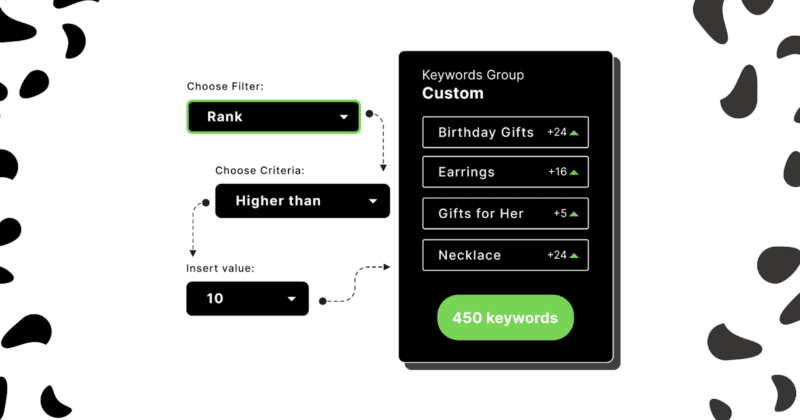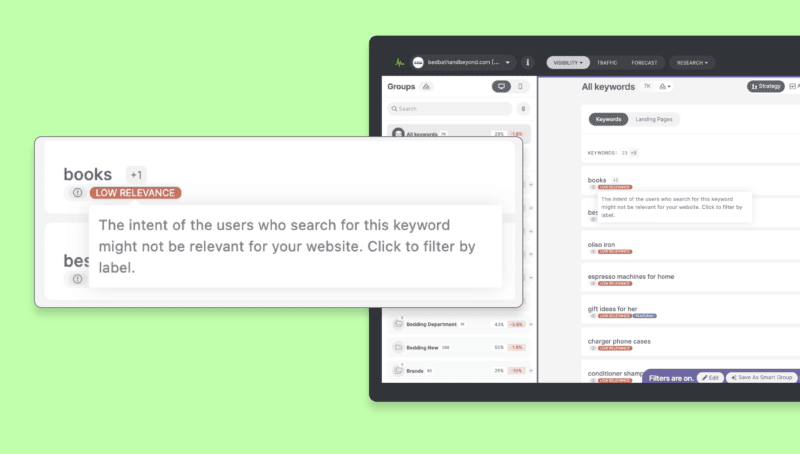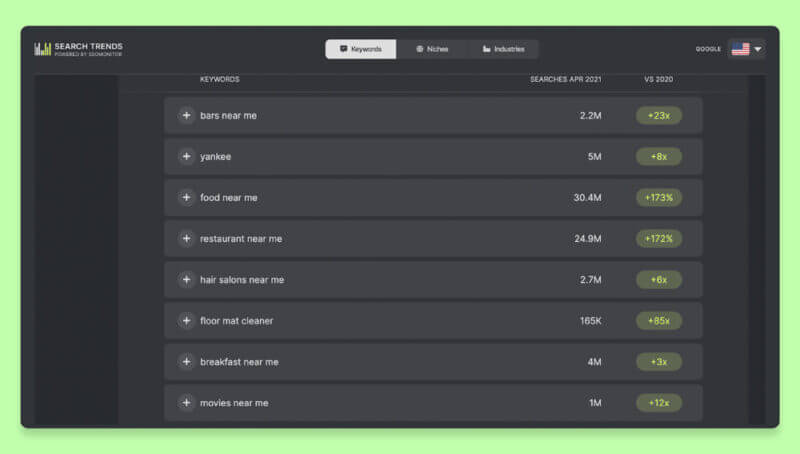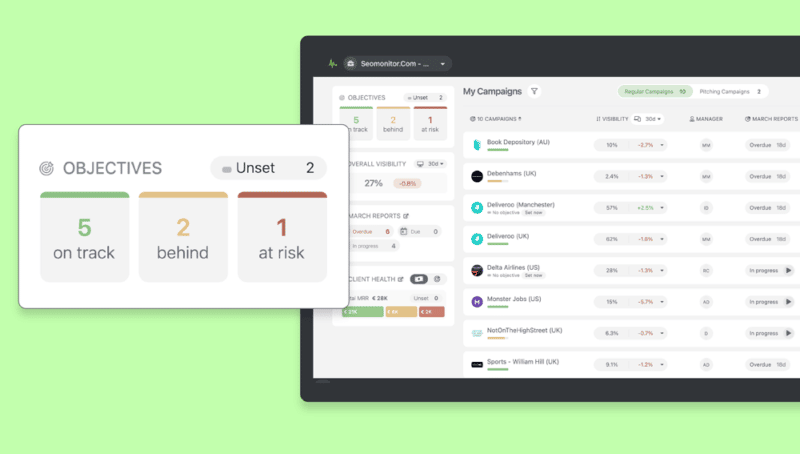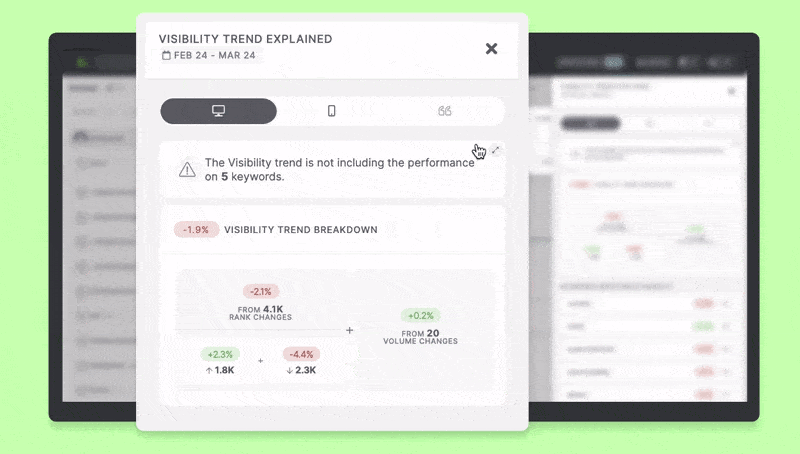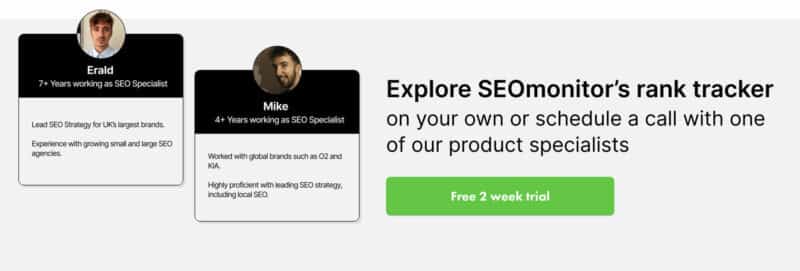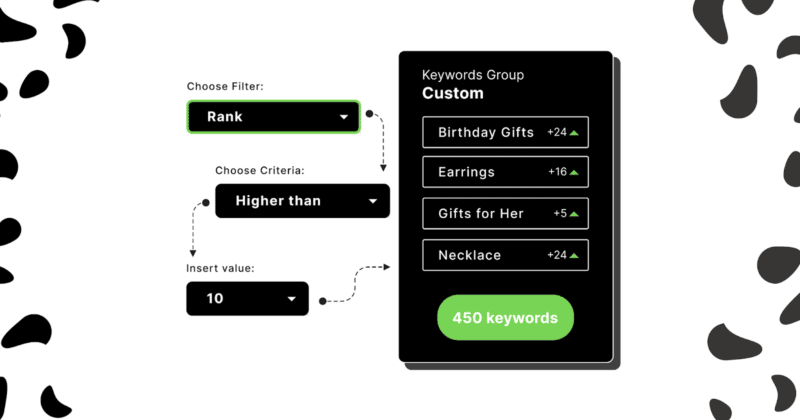
You’re probably expected to manage tens or hundreds of thousands of keywords at a microscopic level, so you don’t miss a thing. And the difficulty only multiplies the more clients you have in your agency portfolio.
Yet, there is so much you can do with your SEO retainer time for one client. So many man-hours pass on routine campaign management and monitoring tasks. Time that you could invest in increasing the value of that account by spotting the next business opportunity.
But it doesn’t have to be like that.
It’s clear that you create the most value by doing strategy for your clients — and tracking every development affecting their keywords is crucial for the campaign’s performance.
So you need a process that helps you leverage the agency’s resources and automate the most labor-intensive parts of the job while controlling strategic interventions on execution.
Here’s how:
Before execution: Segment your keywords strategically.
You can start thinking about an efficient management process from the strategy phase — how you choose your SEO battles reflects how you segment your keywords.
That means categorizing them so you can:
- edit irrelevant and misleading keywords from the start,
- quickly scan your keyword groups and see how they evolve,
- closely watch the keyword opportunities you’re actively building content around,
- keep an eye on keywords that your client wants you to focus on.
That means categorizing them so you can:
- edit irrelevant and misleading keywords from the start,
- quickly scan your keyword groups and see how they evolve,
- closely watch the keyword opportunities you’re actively building content around,
- keep an eye on keywords that your client wants you to focus on.
Eliminate harmful or misleading keywords for an effective campaign
Understanding and acting on your client’s SEO opportunities highly depends on the quality of keywords you choose.
That’s why it’s essential to filter signal from noise — focusing on the insights that would be valuable to the client’s expectations and doing away with the large volume of irrelevant data. Automated keyword research usually has its pitfalls, because keywords that aren’t important to your objectives, or that can waste your time and budget can inflate your list. We’re talking about such keywords as:
- Misspelled keywords — that can duplicate your search volume data if they’re not included in close aggregations.
- Low-relevance keywords — that can’t account for the user’s intent with your website offerings.
- Low search volume keywords (<50 searches per month) — that even at their ranking best will create a low ROI for the campaign.
With SEOmonitor’s rank tracker, filtering out the noise is easier than ever. Based on your website input, the platform can do the research for you and automatically group keywords into categories that make sense from an SEO perspective (e.g., high opportunity, keywords with issues, highly seasonal, etc.) while labeling or downright excluding misleading or harmful keywords.
Choose the relevant keywords from the start.
You need to identify and leverage the high opportunity keywords, so you make the most of your agency and your client’s resources.
Here segmentation becomes the act of translating the client’s business strengths into actionable tactics through two significant lenses: the client’s website categories and target audience, and the business/SEO opportunities:
The buyer’s journey
Segmenting keywords based on customer journey (from the basic “awareness, interest, consideration” model) allows you to provide more targeted value for each type of customer. For example, for buyers in the awareness stage, you want to create content that targets users with search intent that’s still somewhat informational, giving them valuable insight into what they’re looking for—and leading you right to your brand.
You already know the client’s business based on your extensive prior research and their key input on target audiences so that you can start your reverse engineering based on the target’s search queries.
With retail and e-commerce, this is generally straightforward—you’d just get the intersection of product category and search intent and quickly spot the opportunity:
- “What is business casual” will prompt a content marketing tactic for your fashion client’s blog or digital PR efforts.
- “Best cocktail dresses” can give you a hint into optimizing a specific landing page for the user’s interest.
- “Short versus long cocktail dress” will highlight a desire to choose the right style for the user, which you can include in your client’s blog or product pages.
- “Buy H&M black cocktail dress” is undoubtedly an indicator for consideration, so you need to make sure all the relevant landing pages are in place.
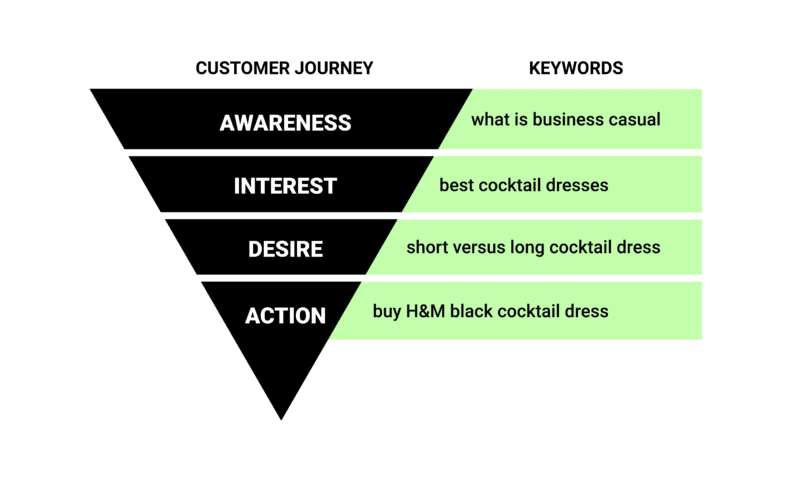
SEO opportunities
It’s also important to identify keywords that you could easily rank highly in but aren’t using yet.
Low SEO difficulty keywords with high search volumes or high conversion data will be a good investment of your resources. For example, your client’s website ranks in the top 20 for “dresses for cocktails” but it doesn’t have “cocktails” in the title — this is a quick win and a straightforward task for you.
These are probably the keywords you should focus your attention on first.
Or you can look at year-over-year search trends and identify exploding keywords: keywords that show a definite ascending trend and that will be relevant to your SEO campaign in the near future. For instance, leveraging the “near me” search queries in the summer-autumn of 2021. Spotting a relevant keyword in the search landscape that none of your competitors are checking out is quite the competitive advantage:
In SEOmonitor’s rank tracker, you can set what we call smart groups. These are dynamic keyword groups that are automatically updated based on the conditional criteria you set, such as landing page, conversions and conversion rate, opportunity, difficulty, revenue, etc.
Having the right keyword groups at a glance makes it easier than ever to manage a multi-faceted campaign targeting various segments and identifying how things are performing.
During execution: Optimize your daily routine.
The reality is, you only have a limited number of hours in a day that you have to prioritize based on your client portfolio. Therefore, to be efficient with time, you need to optimize your daily routine as you enter the campaign management phase — the big chunk of your workflow, most probably.
Easily check critical insights.
The first thing you need to make it an efficient process is to establish key performance indicators and a system for easily monitoring campaign progress towards SEO goals:
The SEO objective status
Can you quickly answer how the overall performance of a specific campaign is progressing?
If you set an objective from the start and track your agency’s performance against it, you will get a clear picture of where you’re heading. This, in turn, will grow your efficiency in managing that campaign — are you on track, or is it at risk?
An agency dashboard that provides a holistic view of each campaign and all your campaigns across the portfolio might come in handy here. Based on your campaign data, you can set up an operational dashboard to give you the critical data at a glance:
- The overall campaign Visibility and its trend on desktop and mobile.
- The client’s objective status tracking.
- The client’s business health based on sessions and conversions data.
The visibility trend
Rank changes are easy to understand and trust. Group-level metrics are not. And manually checking the visibility for each keyword would be insane.
So you need a Visibility metric that is consistent and reliable. Calculated as an impression share, weighted against search volume, this metric will help your team understand how each target group is faring on desktop and mobile.
Still, you need to explain what changed. And do so without being misled by non-SEO performance actions like adding or deleting keywords from your campaign and so on.
That’s why SEOmonitor’s rank tracker automatically explains the keyword-level causes behind the changes in a group’s visibility, based on performance, while the algorithm guards against including your administrative actions.
However, all this automation can only make things easier, not complete the task by itself. You still need to look at the data and employ your intuition and experience to identify a cause.
Keyword issues and alerts
SEO is a constantly shifting battleground, and you need to stay on top of changes in real-time if you want to maintain competitive rankings. Yet, without automation in place, you’d have to check these manually at regular intervals, spending time on tedious tasks without the guarantee that you’ll catch a significant change as it happens.
With tools like SEOmonitor, you can set email alerts for when the visibility changes or check critical insights in the overall campaign view on your dashboard, categorized as:
- Issues — missing landing page for a target keyword, keyword cannibalization, etc.
- Victories — keywords achieving their best rank, SEO objective overachieved, etc.
- Losses — Visibility drops on specific keyword groups or across the SEO campaign
- Opportunities — new keywords that are generating clicks but need to be tracked in your campaign
- Competition trends — competitors outranked or, on the contrary, a competitor’s Visibility increased or decreased, etc.
- Market trends — YoY trend for All keywords, seasonality trends, etc.
No matter the system you choose to use, don’t forget to make it streamlined and repeatable, with the nudges in place to help you work smarter.
Block time for reporting and leverage automation
To accelerate your monthly reporting process, think about it throughout your campaign management, not just when you’re getting close to the actual report deadline.
If you make it a process on its own, with insights saved as you get them, annotations on important changes, and faster data curation, you’ll get the time needed to craft the narrative — and better explain what happened to your client.
Let’s take a look at each of them!
Use the power of annotations.
As we’ve seen until now, categorizing keywords is essential, as they’ll give you group-level metrics that:
- Report which categories have shifted
- Monitor the keyword sets you’re building content around
- Observe the keywords your clients are looking to optimize
So you already have key metrics to assess during your daily or weekly processes. You can leverage this process to include quick saves and annotations on Visibility changes, ranks achieved, etc.
Once you have the insights you deem relevant, you can manually annotate the findings — adding notes as to why you think something has increased or dropped. Then, should something happen frequently, you can look back at your notes while writing your monthly report to backtrack accordingly.
Automate your monthly report building where it counts
As we’ve already hinted at, data gathering is a hassle when you need to open 3-4 tools, many spreadsheets, create screenshots, and so on.
To go even deeper with efficiency, aside from saving crucial information as you see it, you can leverage data curation with tool integrations. Once you’ve decided to include such inputs as SEO objective status, group Visibility trends, key ranking changes, competitors’ status, etc., you can think about automating the data extraction process — with API, Google Data Studio, or even Google Sheets.
Then, you should define an agency template to make the process streamlined across the organization and keep your communication clear. You’ve already set the expectations with each client, know what the KPIs to report on are, and other necessary tasks included.
In a nutshell
The end goal is to implement an efficient process from the start, leaving room for building strategies and thinking creatively—the factors that will drive client satisfaction and retention.
Create an efficient system by:
- Optimizing your daily routine
- Choosing the right keywords to focus on
- Segmenting your keyword strategically, so you don’t waste resources
- Blocking time for reporting
- Using automation for insights gathering and monitoring.
Leverage SEOmonitor’s Rank Tracker and Reporting Management system to save time and resources with efficient campaign management. Keep track of everything happening in client campaigns without painstakingly going through each contributing factor every day.
Let us help in your journey to manage campaigns more efficiently — not just one keyword at a time.
The post Is it time to completely rethink your keyword management process? appeared first on Search Engine Land.
Source: IAB

